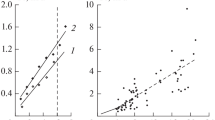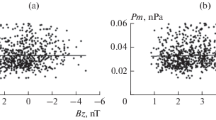Abstract
The data from the DMSP F7 satellite for 1986 are used to study the behavior of ion pressure at the boundaries of auroral precipitation. The study is based on 7489 satellite passages in the nightside sector of the auroral zone, including over 5000 passages in the 2100–2400 MLT sector. Ion pressure is determined as the average for 5 s of observations, which corresponds to a distance of ~40 km in the satellite trajectory portions adjacent to the precipitation boundaries. It is shown that the plasma pressure at the boundaries of auroral precipitation almost linearly increases at all levels of magnetic activity with an increase in the solar wind dynamic pressure (Psw). The pressure distribution as a function of MLT indicates that the precipitation boundaries, including the isotropy boundary, are not isobars, even at a low level of geomagnetic activity. The plasma pressure is maximal in the 22–24 MLT sector and decreases both in the morning and evening sides. The latitudinal position of the precipitation boundaries and the plasma pressure at the boundaries are found during all the phases of a typical substorm with an intensity of AL = –410 nT at its maximum. The latitudinal profile of ion pressure is constructed with respect to the isotropy boundary (IB) at the beginning of substorm. It is shown that, with an increase in dynamic pressure, there is not only a substantial increase in plasma pressure at the auroral precipitation boundaries but also a change in the latitudinal position of the boundaries themselves. As Psw grows, the latitude of the polarward boundary of the oval increases, while that of the equatorward boundary decreases. Despite the considerable expansion of the precipitation region, the latitudinal pressure gradient between the oval boundaries increases, even during quiet periods (average AL = –18 nT, IMF Bz = +1.4 nT) without any disturbances in the auroral zone, by approximately a factor of 2, from 0.06 to 0.12 nPa/deg.







Similar content being viewed by others
REFERENCES
Angelopoulos, V., Kennel, C.F., Coroniti, F.V., et al., Characteristics of ion flow in the quiet state of the inner plasma sheet, Geophys. Res. Lett., 1993, vol. 20, no. 16, pp. 1711–1714. https://doi.org/10.1029/93GL00847
Antonova, E.E., Kirpichev, I.P., Vovchenko, V.V., Stepanova, M.V., Riazantseva, M.O., Pulinets, M.S., Ovchinnikov, I.L., and Znatkova, S.S., Characteristics of plasma ring, surrounding the Earth at geocentric distances ~7–10 RE, and magnetospheric current systems, J. Atmos. Sol.-Terr. Phys., 2013, vol. 99, nos. 85–91. https://doi.org/10.1016/j.jastp.2012.08.013
Antonova, E.E., Vorobjev, V.G., Kirpichev, I.P., and Yagodkina, O.I., Comparison of the plasma pressure distributions over the equatorial plane and at low altitudes under magnetically quiet conditions, Geomagn. Aeron. (Engl. Transl.), 2014a, vol. 54, no. 3, pp. 278–281. https://doi.org/10.7868/S001679401403002X
Antonova, E.E., Kirpichev, I.P., and Stepanova, M.V., Plasma pressure distribution in the surrounding the Earth’s plasma ring and its role in the magnetospheric dynamics, J. Atmos. Sol.-Terr. Phys., 2014b, vol. 115, pp. 32–40. https://doi.org/10.1016/j.jastp.2013.12.005
Antonova, E.E., Vorobjev, V.G., Kirpichev, I.P., Yagodkina, O.I., and Stepanova, M.V., Problems with mapping the auroral oval and magnetospheric substorms, Earth, Planets Space, 2015, vol. 67, id 166. https://doi.org/10.1186/s40623-015-0336-6
Antonova, E.E., Stepanova, M., Kirpichev, I.P., et al., Structure of magnetospheric current systems and mapping of high latitude magnetospheric regions to the ionosphere, J. Atmos. Solar-Terr. Phys., 2018, vol. 177, pp. 103–114. https://doi.org/10.1016/j.jastp.2017.10.013
Baumjohann, W., Paschmann, G., and Cattell, C.A., Average plasma properties in the central plasma sheet, J. Geophys. Res., 1989, vol. 94, no. 6, pp. 6597–6606. https://doi.org/10.1029/JA094iA06p06597
Goertz, C.K. and Baumjohann, W., On the thermodynamics of the plasma sheet, J. Geophys. Res., 1991, vol. 96, no. A12, pp. 20991–20998. https://doi.org/10.1029/91JA02128
Kirpichev, I.P. and Antonova, E.E., Plasma pressure distribution in the equatorial plane of the Earth’s magnetosphere at geocentric distances of 6–10 R E according to the international THEMIS mission data, Geomagn. Aeron. (Engl. Transl.), 2011, vol. 51, no. 4, pp. 450–455.
Kirpichev, I.P., Yagodkina, O.I., Vorobjev, V.G., and Antonova, E.E., Position of projections of the nightside auroral oval equatorward and poleward edges in the magnetosphere equatorial plane, Geomagn. Aeron. (Engl. Transl.), 2016, vol. 56, no. 4, pp. 407–414. https://doi.org/10.7868/S0016794016040064
Newell, P.T., Wing, S., Meng, C.-I., and Sigillito, V., The auroral oval position, structure, and intensity of precipitation from 1984 onward—An automated on-line database, J. Geophys. Res., 1991, vol. 96, no. A4, pp. 5877–5882. https://doi.org/10.1029/90JA02450
Newell, P.T., Feldstein, Y.I., Galperin, Yu.I., and Meng, C.-I., Morphology of nightside precipitation, J. Geophys. Res., 1996, vol. 101, no. A5, pp. 10737–10778. https://doi.org/10.1029/95JA03516
Newell, P.T., Sergeev, V.A., Bikkuzina, G.R., and Wing, S., Characterizing the state of the magnetosphere: Testing the ion precipitation maxima latitude (b2i) and the ion isotropy boundary, J. Geophys. Res., 1998, vol. 103, no. A3, pp. 4739–4746. https://doi.org/10.1029/97JA03622
Paschmann, G., Haaland, S., and Treumann, R., Auroral plasma physics, Space Sci. Rev., 2002, vol. 103, pp. 1–485. https://doi.org/10.1023/A:1023030716698
Sergeev, V.A., Sazhina, E.M., Tsyganenko, N.A., Lundblad, J.A., and Soraas, F., Pitch-angle scattering of energetic protons in the magnetotail current sheet as the dominant source of their isotropic precipitation into the nightside ionosphere, Planet. Space Sci., 1983, vol. 31, no. 10, pp. 1147–1155. https://doi.org/10.1016/0032-0633(83)90103-4
Starkov, G.V. and Feldshtein, Ya.I., Substorms in polar auroras, Geomagn. Aeron., 1971, vol. 11, no. 3, pp. 563–565.
Starkov, G.V., Rezhenov, B.V., Vorobjev, V.G., Feldshtein, Ya.I., and Gromova, L.I., Dayside auroral precipitation structure, Geomagn. Aeron. (Engl. Transl.), 2002, vol. 42, no. 2, pp. 176–183.
Starkov, G.V., Rezhenov, B.V., Vorobjev, V.G., and Feldshtein, Ya.I., Planetary distribution of auroral precipitation and its relation to the zones of auroral luminosity, Geomagn. Aeron. (Engl. Transl.), 2003, vol. 43, no. 5, pp. 569–578.
Starkov, G.V., Vorobjev, V.G., and Feldshtein, Ya.I., Relative position of the regions of auroral precipitation and discrete auroras, Geomagn. Aeron. (Engl. Transl.), 2005, vol. 45, no. 2, pp. 170–180.
Stepanova, M.V., Antonova, E.E., Bosqued, J.M., Kovrazhkin, R.A., and Aubel, K.R., Asymmetry of auroral electron precipitations and its relationship to the substorm expansion phase onset, J. Geophys. Res., 2002, vol. 107, no. A7. https://doi.org/10.1029/2001JA003503
Stepanova, M., Antonova, E.E., and Bosqued, J.-M., Study of plasma pressure distribution in the inner magnetosphere using low-altitude satellites and its importance for the large-scale magnetospheric dynamics, Adv. Space Res., 2006, vol. 38, no. 8, pp. 1631–1636. https://doi.org/10.1016/j.asr.2006.05.013
Stepanova, M., Antonova, E.E., Moya, H.S., Pinto, V.A., and Valdivia, J.A., Multisatellite analysis of plasma pressure in the inner magnetosphere during the 1 June 2013 geomagnetic storm, J. Geophys. Res., 2019., vol. 124, no. 2. https://doi.org/10.1029/2018JA025965
Tsyganenko, N.A. and Mukai, T., Tail plasma sheet models derived from geotail particle data, J. Geophys. Res., 2003, vol. 108, no. A3, 1136. https://doi.org/10.1029/2002JA009707
Vorobjev, V.G., Yagodkina, O.I., Starkov, G.V., and Feldstein, Ya.I., A substorm in midnight auroral precipitation, Ann. Geophys., 2003, vol. 21, no. 12, pp. 2271–2280. https://doi.org/10.5194/angeo-21-2271-2003
Vorobjev, V.G., Yagodkina, O.I., and Katkalov, Y., Auroral precipitation model and its applications to ionospheric and magnetospheric studies, J. Atmos. Sol.-Terr. Phys., 2013, vol. 102, pp. 157–171. https://doi.org/10.1016/j.jstp.2013.05.007
Vorobjev, V.G., Yagodkina, O.I, and Antonova, E.E., Features of the planetary distribution of ion precipitation at different levels of magnetic activity, Geomagn. Aeron. (Engl. Transl.), 2015, vol. 55, no. 5, pp. 585–595. https://doi.org/10.7868/S0016794015050193
Wing, S. and Newell, P.T., Center plasma sheet ion properties as inferred from ionospheric observations, J. Geophys. Res., 1998, vol. 103, no. A4, pp. 6785–6800. https://doi.org/10.1029/97JA02994
Wing, S., Gkioulidou, M., Johnson, J.R., Newell, P.T., and Wang, C.-P., Auroral particle precipitation characterized by the substorm cycle, J. Geophys. Res., 2013, vol. 118, pp. 1022–1039. https://doi.org/10.1002/jgra.50160
Yahnin, A.G., Sergeev, V.A., Gvozdevsky, B.B., and Vennerstrøm, S., Magnetospheric source region of discrete auroras inferred from their relationship with isotropy boundaries of energetic particles, Ann. Geophys., vol. 15, no. 8, pp. 943–958. https://doi.org/10.1007/s00585-997-0943-z
ACKNOWLEDGMENTS
The DMSP F7 satellite data were taken from the website http://sd-www.jhuapl.edu; the IMF and solar wind plasma parameters and the magnetic-activity indices were taken from the websites http://wdc.kugi.kyoto-u.ac.jp/ and http://cdaweb.gsfc.nasa.gov/.
Author information
Authors and Affiliations
Corresponding author
Additional information
Translated by A. Kobkova
Rights and permissions
About this article
Cite this article
Vorobjev, V.G., Yagodkina, O.I. & Antonova, E.E. Ion Pressure at the Auroral Precipitation Boundaries and Its Relationship with the Solar Wind Dynamic Pressure. Geomagn. Aeron. 59, 543–553 (2019). https://doi.org/10.1134/S0016793219050141
Received:
Revised:
Accepted:
Published:
Issue Date:
DOI: https://doi.org/10.1134/S0016793219050141




